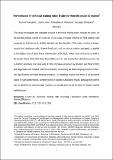Files in this item
Performance of technical trading rules : evidence from the crude oil market
Item metadata
| dc.contributor.author | Psaradellis, Ioannis | |
| dc.contributor.author | Laws, Jason | |
| dc.contributor.author | Pantelous, Athanasios | |
| dc.contributor.author | Sermpinis, Georgios | |
| dc.date.accessioned | 2020-05-26T23:36:47Z | |
| dc.date.available | 2020-05-26T23:36:47Z | |
| dc.date.issued | 2019-11-22 | |
| dc.identifier | 256667904 | |
| dc.identifier | 08cc7ce6-1bd7-4ade-ac86-7273386c6e28 | |
| dc.identifier | 85057599714 | |
| dc.identifier | 000489682000009 | |
| dc.identifier.citation | Psaradellis , I , Laws , J , Pantelous , A & Sermpinis , G 2019 , ' Performance of technical trading rules : evidence from the crude oil market ' , European Journal of Finance , vol. 25 , no. 17 , pp. 1793-1815 . https://doi.org/10.1080/1351847X.2018.1552172 | en |
| dc.identifier.issn | 1351-847X | |
| dc.identifier.other | ORCID: /0000-0002-7628-8931/work/60196824 | |
| dc.identifier.uri | https://hdl.handle.net/10023/19997 | |
| dc.description | This work was supported by the EPSRC and ESRC Centre for Doctoral Training on Quantification and Management of Risk & Uncertainty in Complex Systems & Environments (EP/L015927/1). | en |
| dc.description.abstract | This study investigates the debatable success of technical trading rules, through the years, on the trending energy market of crude oil. In particular, the large universe of 7846 trading rules proposed by Sullivan, Timmermann, and White (1999. “Data-Snooping, Technical Trading Rule Performance, and the Bootstrap.” The Journal of Finance 54 (5): 1647–1691. doi:10.1111/0022-1082.00163), divided into five families (filter rules, moving averages, support and resistance rules, channel breakouts, and on-balance volume averages), is applied to the daily prices of West Texas Intermediate (WTI) light, sweet crude oil futures as well as the United States Oil (USO) fund, from 2006 onwards. We employ the k-familywise error rate (k-FWER) and false discovery rate (FDR) techniques proposed by Romano, J. P., and M. Wolf. (2007. “Control of Generalized Error Rates in Multiple Testing.” The Annals of Statistics 35 (4): 1378–1408. doi:10.1214/009053606000001622) and Bajgrowicz, P., and O. Scaillet. (2012. “Technical Trading Revisited: False Discoveries, Persistence Tests, and Transaction Costs.” Journal of Financial Economics 106 (3): 473–491. doi:10.1016/j.jfineco.2012.06.001) respectively, accounting for data snooping in order to identify significantly profitable trading strategies. Our findings explain that there is no persistent nature in rules performance, contrary to the in-sample outstanding results, although tiny profits can be achieved in some periods. Overall, our results seem to be in favor of interim market inefficiencies. | |
| dc.format.extent | 23 | |
| dc.format.extent | 647387 | |
| dc.language.iso | eng | |
| dc.relation.ispartof | European Journal of Finance | en |
| dc.subject | Crude oil | en |
| dc.subject | Technical trading | en |
| dc.subject | Data snooping | en |
| dc.subject | Transaction costs | en |
| dc.subject | Persistence | en |
| dc.subject | Market efficiency | en |
| dc.subject | HG Finance | en |
| dc.subject | NDAS | en |
| dc.subject | BDC | en |
| dc.subject | R2C | en |
| dc.subject.lcc | HG | en |
| dc.title | Performance of technical trading rules : evidence from the crude oil market | en |
| dc.type | Journal article | en |
| dc.contributor.institution | University of St Andrews. School of Economics and Finance | en |
| dc.identifier.doi | 10.1080/1351847X.2018.1552172 | |
| dc.description.status | Peer reviewed | en |
| dc.date.embargoedUntil | 2020-05-27 |
This item appears in the following Collection(s)
Items in the St Andrews Research Repository are protected by copyright, with all rights reserved, unless otherwise indicated.

